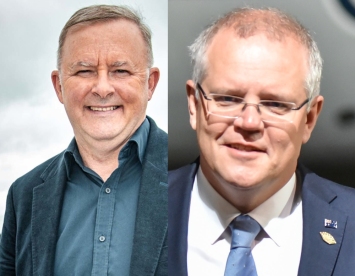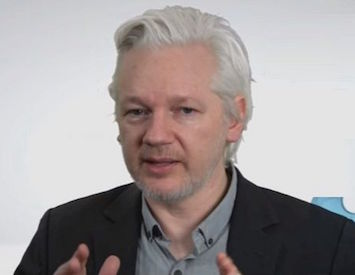The Trump ascendancy presents an opportunity to challenge Australia's unquestioning commitment to the U.S. alliance, writes James O'Neill.
THE ELECTION of a new U.S. president presents a perfect opportunity for Australia to rethink its political and strategic dependency on the United States.
In the course of the election campaign, both Trump and his Democratic Party rival Hillary Clinton put forward clear but very different foreign policy images. Trump spoke, for example, of wanting to have a dialogue with Russian President Putin; of not wishing the U.S. to be further involved in the war in Syria; and departing from the long-standing American policy of seeking “regime change” in the governments of foreign countries that showed insufficient deference to Washington’s interests and wishes.
Clinton, on the other hand, openly advocated a no-fly zone in Syria and seemed to think that the U.S. had the right to bomb Iran. Not only did these policies risk an open confrontation and possible war with Russia and China, they appeared to rest on no more than a continuation of American “exceptionalism” as their justification.
It is by no means clear that Trump will even survive until inauguration day on 20 January 2017, given the determined effort of Clinton and her proxies to contest the election result in key states and the animosity his policies have evoked.
Assuming that Trump is inaugurated, the main question will be whether the hopeful elements emerging from his campaign will translate into actual policies, or whether the external forces upon all U.S. presidents dictate a continuation of business as usual.
The post-election signs are not altogether promising. Trump has announced appointments to his proposed cabinet and, as close advisers, persons that are variously rich, overwhelmingly white and with reputations that completely repudiate any image of persons who might be interested in seeking peaceful and negotiated resolution of major problems.
Quite what policy path they will actually pursue is unclear, as Trump has reversed or modified his position on a number of key issues, from climate change to a trade war with China. Even provocative gestures such as taking a telephone call from the president of Taiwan may be no more than creating bargaining chips. Trump is much more at home in the wheeling and dealing milieu than he is in the subtleties of diplomacy.
The major challenge for Australia will be adjusting to policy shifts, if any, by the U.S. in the foreign policy area. On the other hand, if those policies are in reality a continuation of business as usual, then the bigger question becomes whether Australia’s national interest is truly served by unswerving loyalty to those policies.
We know, for example, from policy documents, as well as statements from a long line of U.S. secretaries of state and defence, and other authoritative sources, that the primary ambition of the U.S. has been to remain the world’s sole superpower. The exercise of that ambition requires the maintenance of what is described as “full spectrum dominance”.
Historically, any threat to that dominance has been ruthlessly suppressed. This ruthlessness takes many forms, including such notable examples as the training, financing, and logistical and other support for jihadist fanatics to create chaos and ungovernability across the Islamic world from Africa to Xinjiang province in China.
This policy has created widespread destruction of countries and people’s lives, leading to the displacement of tens of millions of persons. Does Australia really want to be a part of a continuation of such policies, or is there an alternative?
As long ago as 1904, British geographer Halford Mackinder, in an address to the Royal Geographical Society in London, envisaged a different type of world. Mackinder spoke about the central importance of what he called the “world island”, by which he meant the great land mass we nowadays call Eurasia.
In 2013, China’s President Xi announced his vision for the New Silk Road — a multi-trillion-dollar infrastructure programme involving initially 28 countries, through high-speed rail links and related developments. Variations on this plan include maritime routes linking the ASEAN nations, India, East Africa, North Africa and countries bordering the Mediterranean.
Of considerable importance is the fact that the New Silk Road strategy has a range of accompanying plans, including linking the countries of the Shanghai Cooperation Organisation (SCO) with the BRICS grouping, the Eurasian Economic Union and the latest project, the Regional Comprehensive Economic Partnership (RCEP).
The membership of these various groupings overlap to a degree and this facilitates an ever-growing greater degree of cooperation. The RCEP is of particular importance for Australia, embodying as it does the ten ASEAN nations, plus China, India, Japan, New Zealand and China. It is clearly a competitor with the Trans-Pacific Partnership (TPP) that both Clinton and Trump opposed, at least nominally.
More importantly, the RCEP seeks trading arrangements that are mutually beneficial to the individual countries, as opposed to the TPP, which was fundamentally a protection racket for American corporations.
Any structure that excludes the world’s largest trading nation, China, is not one that is serious about trade liberalisation. Apart from its investor-state dispute resolution procedures, an unparalleled attack on national sovereignty, and the aforementioned benefits to American corporations, the TPP was an essential component of the U.S.’ geopolitical aim to “contain” China, and prevent its further emergence as a threat to U.S. hegemony in the Pacific and elsewhere.
A less well-known development is the revolution occurring in the world’s payments system. American geopolitical hegemony rested to a considerable degree on the dollar’s role as the world’s sole reserve currency. International trade was conducted in dollars, which ensured their continuing demand. That demand enabled the U.S. to wage its wars, essentially using other countries to cover their enormous deficits.
That particular bubble is in the process of being burst. The Yuan is now part of a basket of reserve currencies. China conducts trade with more than 60 nations using their own currencies. A Chinese-based credit system, to replace the Western dominated SWIFT system, is now in place.
As might be expected, the Americans have not stood idly by watching these developments. Their reaction reflects a pattern well established over the past 70 years.
There are now over 400 U.S. military bases, including in Australia, whose main role is to threaten and “contain” China. Many of those bases have nuclear weapons. The Pine Gap base in Central Australia is a key component of the U.S. electronic surveillance systems, as well as essential to the conduct of drone warfare. It is assuredly a prime target in any actual war.
Apart from the well-documented use of jihadist terrorists for their geopolitical purposes, such devices as the so-called "colour revolutions" are also destabilising tools in, for example, Thailand and Hong Kong.
Most significantly, from Australia’s point of view, given the dilemmas posed by China being at one and the same time by far the country’s largest trading partner – and also officially an existential threat to Australia’s security – is its involvement in the huge propaganda campaign over the South China Sea.
Part of that involvement is Australia’s participation in Exercise Talisman Sabre, an annual American-led naval exercise that practices the blocking of the Malacca Strait, a narrow waterway of immense importance to China’s trade, particularly in oil and gas from the Middle East.
Despite there being zero evidence of China ever hindering civilian shipping – there or anywhere else – the Talisman Sabre exercise, together with other daily provocations, is carried out under the pretext of "freedom of navigation". In the light of the U.S. record, that is a particularly ironic designation.
Quite apart from the hypocrisy, such exercises are also incredibly dangerous – on a par with Clinton’s no-fly zones in Syria – in creating a potentially rapid deterioration into a nuclear confrontation.
Which brings one back to the original question. In the light of the evidence of the past 70 years, is it possible to sustain a serious argument that the U.S. alliance is remotely in Australia’s interests? Even to raise the question in Australia is very difficult, as evidenced by the reaction to suggestions by Senator Penny Wong and former prime minister Paul Keating, that the Trump ascendancy was an opportunity to raise precisely this question.
The mainstream media in Australia is as wedded to the Anglo-American mindset as the politicians. A clear-eyed analysis of post-World War II history leads to the conclusion that U.S. and Australian vital interests diverge sharply. Notwithstanding that divergence of interest, Australia has deluded itself that involvement in a continuing series of illegal American wars – from Vietnam, through Afghanistan, to Iraq and currently Syria – is essential to maintain the illusion of an American security guarantee.
Donald Trump's election as the next U.S. President, not least because of his own pronouncements on the issue, is an opportunity for Australia to reevaluate its real national interests. The opening up of trade and development opportunities in our region referred to above, provide a feasible alternative to constant warmongering.
In a very literal sense, time is rapidly running out. Making the wrong strategic choices will impose incalculable damage on the lives of future generations. It is an opportunity for a different future that should not be squandered.
James O'Neill is a former academic and has practiced as a barrister since 1984. He writes on geopolitical issues, with a special emphasis on international law and human rights. He may be contacted at joneill@qldbar.asn.au.

This work is licensed under a Creative Commons Attribution-NonCommercial-NoDerivs 3.0 Australia License
Monthly Donation
Single Donation
Be independent. Subscribe to IA for just $5.









